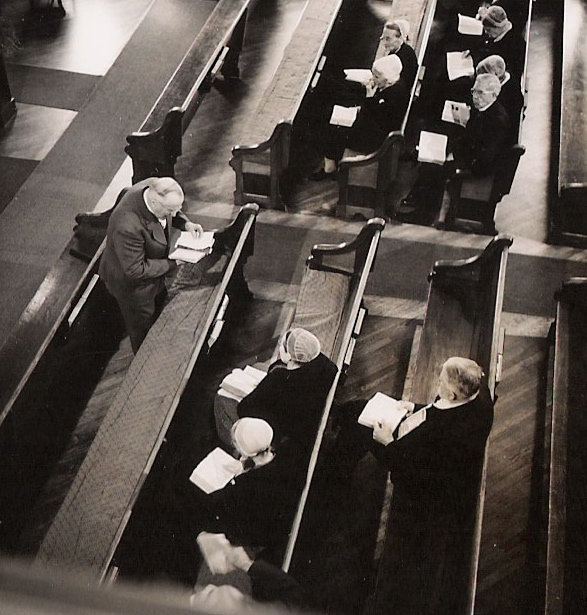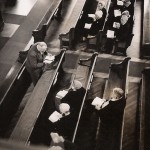
In its March 22, 1954 issue, Life magazine published a feature article on “President Eisenhower’s Religion.” Given Ike’s roots in the Brethren in Christ Church, the article devotes significant space to descriptions of the denomination’s Abilene congregation, where Ike attended Sunday school for a period in the early 1900s.
The photographs of the Abilene congregation — including the one that serves as today’s Photo Friday installment, which received a major focus in Life — are breathtakingly beautiful, presenting an image of the mid-century Brethren in Christ as a plain and peaceful people.
Check out more images from the shoot, after the jump.
The photographer is clearly enamored of the plain dress worn by church members, and by the unadorned church building in which they worship. His focus seems to emphasize the “other-ness” of these “plain people” — something that often happens today in media coverage of Anabaptist groups like the Old Order Amish, for instance.
Readers: How do you respond to these photographs?


Thanks, Devin.
I appreciate the photo & story links.
Blessings,
Ken
My first response are two questions:
1. Although I’ve read of the influence of the Brethren in Christ upon Eisenhower, i.e., when he was a child,* how does one understand (or maybe chart/summarize) the lasting influence of the Brethren in Christ?
2. How does the influence of the Brethren in Christ compare to the Russellite movement (forerunner of the Jehovah’s Witnesses) and the Presbyterian Church?
*e.g., http://www.dwightdeisenhower.com/dreams/newchurch99.html and http://www.eisenhower.archives.gov/Research/Subject_Guides/PDFs/Eisenhower_and_religion.pdf
Devin–I recall reading an extensive article on Eisenhower’s religious background that deals more fully with the Jehovah’s Witness influence. Here’s the link for that: http://www.seanet.com/~raines/eisenhower.html
Some pews have cushions, others do not.
I think that the love and goodness of those kind people influenced Ike’s character and religion, despite their plain dress. I feel that the media has romanticized the dress of the Amish and Catholic Nuns. Those are beautiful actresses and handsome actors in the movies and TV shows. Appearance is not really important, but I don’t think that Christ has called us to wear a costume. I had an aunt who wore the caped dress and the plainest covering with strings (as shown above) until she died in the 1970’s. But she still took delight in choosing the fabric patterns, usually with various colors of little flowers. Dress can be a creative act, without being gaudy and expensive.